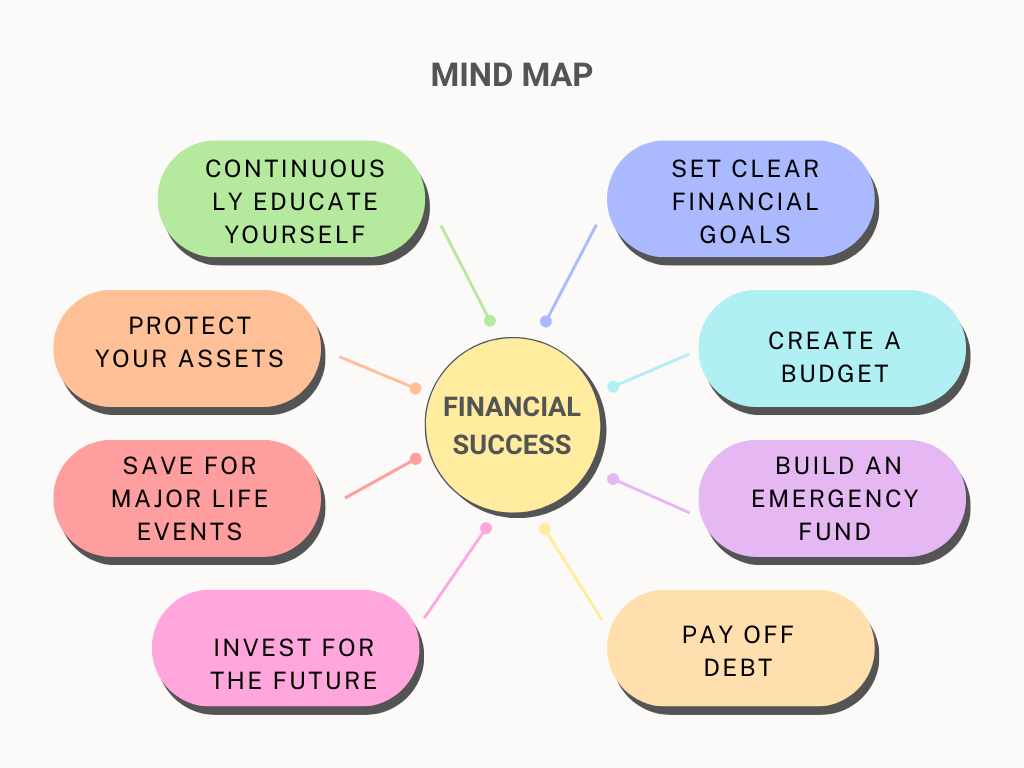Introduction
To be financially successful, you need to do more than just get rich. You also need to be financially stable, have peace of mind, and be able to reach your life goals. It’s a complete way to handle your money so that you can have a safe future.
Knowing how important financial success is gives people the power to make smart choices, lower their stress, and lay the groundwork for a happy life. There are steps to take to become financially free and independent.
Let’s set the stage for a good financial journey before we get into the steps. It starts with changing the way you think about money, realizing how important it is, and being willing to learn and change.

Step-by-Step to Financial Success
Step 1: Set Clear Financial Goals
Identifying Short-Term and Long-Term Goals
Write down your goals, whether they’re to buy a house, visit the world, or retire in comfort. Being able to tell the difference between short-term and long-term goals gives you focus and direction.
Making Goals SMART
Craft goals that are Specific, Measurable, Achievable, Relevant, and Time-bound (SMART). This strategic approach ensures that your objectives are realistic and attainable.

Prioritizing Goals
Every goal is different. Set priorities based on how important, how quickly, and how they will affect your total financial health. Now you have a plan for how to handle your money.
Step 2: Create a Budget

Understanding Your Current Financial Situation
Before you make a budget, you should look at your current debts, income, and spending. To make good financial planning., you need to know what your present position is.
Income and Expense Tracking
Keep careful records of all the money you earn and everything you spend. Keeping track of your spending can help you find places to save money, invest, and cut back.
Creating a Realistic Budget
Making a budget means deciding how much money to spend on necessities, saves, and extras. Aim for balance, and make changes as needed to stay on track with your goals.
Allocating Funds for Essentials, Savings, and Discretionary Spending
Set aside some of your cash for savings, necessary expenses, and fun things. This sensible method keeps your finances stable while still letting you have fun.
Step 3: Build an Emergency Fund

Importance of Emergency Funds
For peace of mind when bad things happen, an emergency fund is like a financial safety net. Learn why this fund is so important for your general money situation.
Determining the Appropriate Fund Size
Find out how much you need in an emergency fund by adding up your regular costs. This fund should cover your monthly bills for three to six months, giving you a safety net in case of an emergency.
Strategies for Saving and Maintaining the Emergency Fund
Look into useful ways to regularly save money and keep your backup fund full. This step sets up cash strength and readiness.
Step 4: Pay off Debt

Identifying and Categorizing Different Types of Debt
Recognize your debts and put them into groups, making sure to separate the high-interest bills from the low-interest ones. This step makes it possible to come up with good ways to pay off debt.
Strategies for Paying off Debt
Check out well-known ways to pay off debt, such as the “debt snowball” or “debt avalanche” method. The best way to do something relies on your tastes and how much money you have.
Reducing Interest Rates and Negotiating with Creditors
Take action to lower your interest rates, talk to your creditors, and speed up the process of paying off your debt. This step gives you the tools you need to take back control of your money.
Step 5: Invest for the Future

The Power of Compound Interest
Learn how compound interest works and how it affects investments that you will keep for a long time. This simple idea is the key to getting richer over time.
Diversification and Risk Management
To effectively control risk, you should diversify your investments. Find out about the different types of assets and how to make a business plan that is well-balanced.
Different Investment Options
Look into different ways to invest, like stocks, bonds, and real estate. Make sure that the way you spend fits with your risk tolerance, your goals, and your time frame.
The Role of Retirement Accounts
Learn how important it is to have savings plans like a 401(k) and an IRA. These accounts are very important for making sure you have money after you stop working.
Step 6: Save for Major Life Events
Planning for Big Expenses
Plan for big events in your life, like going to college, buying a house, or getting married. When you plan ahead, you can save money and be financially ready.
Setting Up Dedicated Savings Accounts
Set up separate savings accounts for each of your goals. Making this planning move will help you stay on track to reach your financial goals.
Creating a Timeline for Achieving These Goals
Set reasonable due dates for completing important life objectives. This step gives your financial plan shape and encourages you to keep saving.
Step 7: Protect Your Assets
The Importance of Insurance
Know that insurance is an important way to protect your financial health. It’s important to know what your health, car, and home insurance covers.
Estate Planning and Creating a Will
Learn more about why estate planning and writing a will are important. These formal papers make sure that your property is divided the way you want.
Risk Management and Emergency Preparedness
Use strategic risk management techniques to lower the financial risks you face. To protect your belongings, get ready for situations and things you didn’t expect.
Step 8: Continuously Educate Yourself
Staying Informed about Financial Trends and Strategies
Keep up with changes in the market, new tactics, and financial trends. Continuing your schooling gives you the power to make smart financial choices.
Seeking Advice from Financial Experts
Don’t be afraid to ask financial pros for help. Getting help from a professional can give you useful information that is specific to your financial position.
Attending Financial Literacy Workshops and Seminars
Take part in classes and courses on financial awareness to learn more. Making connections with people who share your interests can also give you new ideas.
Step 9: Monitor and Adjust
Regularly Reviewing Your Financial Situation
Plan to look over your finances on a routine basis. This proactive method helps you see where you need to improve and keeps you on track.
Making Necessary Adjustments to Your Budget and Financial Plan
Make any necessary changes to your budget and financial plan. Life changes, and so should your financial plan. It should adapt to new situations.
Celebrating Milestones and Achievements
Take a moment to recognize and enjoy your cash achievements. Seeing what you’ve accomplished pushes you to keep going on your financial path.
Conclusion
Think about how taking these steps makes you feel safe and healthy. There’s more to financial success than just numbers; it’s about making your life full and peaceful.
Now is the best time to start on the path to financial success if you haven’t already. Just do the first thing, and the rest will fall into place.
In order to reinforce the basic rules of financial success, you should summarize the most important things you learned from each step.





